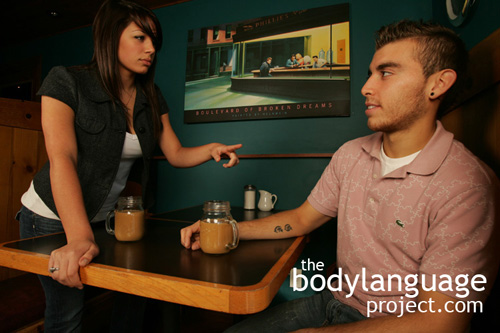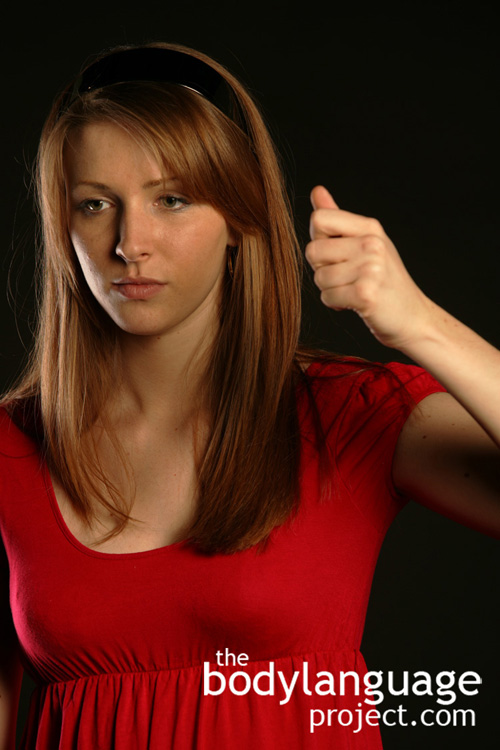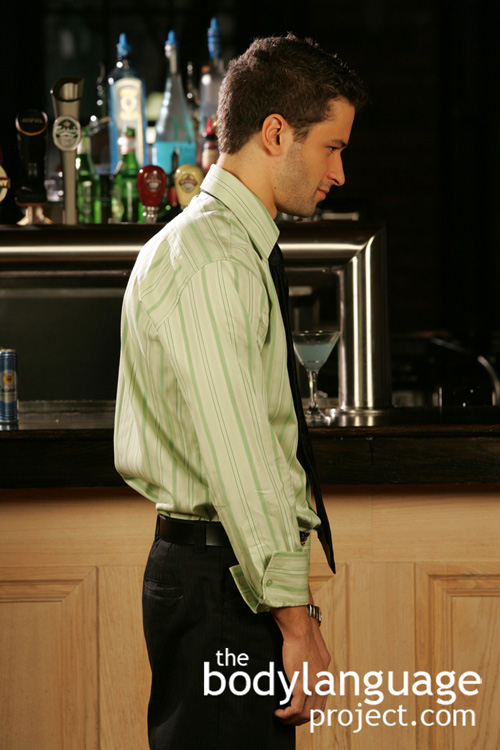Body Language of Erect Posture or Good Posture
 Cue: Erect Posture or Good Posture.
Cue: Erect Posture or Good Posture.
Synonym(s): Postural Tonus, Good Posture, High Stand Display.
Description: Good posture happens when the joints are not bent, the spine is aligned and not twisted and the person is able to optimally balance the mass of the body over its framework without stress.
In One Sentence: Good posture signifies health, confidence, pride, dominance and a body that is in control of itself.
How To Use it: Use good posture to tell others that life is treating you well and that you have conquered past hardships without letting it weigh you down. Good posture should be a default body position as it works to your advantage in nearly every situation. However, in some cases, you may wish to use bad posture such as when trying to convince others to provide you with sympathy. In this case, being slumped over is likely to best provide that kind of support.
Therefore, use good posture when trying to appear authoritative such as when trying to rise in the ranks in employment, in view of a dating partner to show virility, and amongst friends to show them you are in good spirits.
Context: General.
Verbal Translation: “Because life has treated me well I hold an erect posture full of confidence and pride.”
Variant: See Cocooning, Shoulder Shrugs or Shoulder Rise, Asymmetry, Bad Posture.
Cue In Action: Mark carried his body with pride. His shoulders were back and chest held high. You just knew looking at him that he would never let life dictate how he felt about himself and he would overcome any obstacle in his way on his way to success.
Meaning and/or Motivation: A gravity defying body posture where the head is raised, legs locked and back stiffened in order to appear taller with high vigor.
It signifies a desire to appear more dominant, authoritative, and in control.
Posture is a term derived from the Latin verb “ponere” meaning “to put in place” and refers to the way the body is held including the arms, legs and spine. Posture refers not only to the erectness of our bodies, but also to our body orientation, direction of lean, and the degree to which our bodies are open and inviting.
Posture tells us a lot about a person and their history and feelings about themselves and how they feel about others. For example, shoulders hunched carries negative sentiments whereas shoulders back mean confidence. Posture can give way to feelings of like or dislike, interest or disinterest as well as many other sentiments.
Postural tonus is a term referring to the relative rigidity and erectness of the body and its overall posture. A “slopper” holds his shoulders rounded and head hanging downward proving to be depressed, drowsy or ill. Whereas “the scout” carries himself fully erect with shoulders back and head held high depicting confidence and good spirit. Having an erect posture is a sign of high confidence, strength and vigor. People with erect postures are seen as leaders, content and positive. Erect posture contrasts a slouched or limp posture.
Cue Cluster: Other positive cues are associated with an erect posture such as strong eye contact, good gesticulation, open body language such as arms uncrossed and legs open, as well as relaxed facial expressions.
Body Language Category: Authoritative body language, Confident body language, Dominant body language, Expansive movements, Gravity defying body language, High confidence body language, Leadership body language, Up nonverbals.
Resources:
Atkinson A, Dittrich W, Gemmell A, Young A. Emotion perception from dynamic and static body expressions in point-light and full-light displays. Perception 2004;33:717–46.
Aviezer H, Trope Y, Todorov A. Body cues, not facial expressions, discriminate between intense positive and negative emotions. Science 2012;338:1225–9.
Allen, Jill; Sarah J. Gervais and Jessi L. Smith. Sit Big to Eat Big: The Interaction of Body Posture and Body Concern on Restrained Eating. Psychology of Women Quarterly 2013. 37(3): 325-336. DOI: 10.1177/0361684313476477pwq.sagepub.com
http://bodylanguageproject.com/articles/sit-big-to-eat-big-how-constrictive-postures-reduce-food-consumption/
Arnette, S. L., & Pettijohn, T. F., II. (2012). The effects of posture on self-perceived leadership. International Journal of Business and Social Science, 3, 8–13.
Bohns, Vanessa K. and Scott S. Wiltermuth. It Hurts When I Do This (Or You Do That): Posture And Pain tolerance. Journal of Experimental Social Psychology. 2012. 48: 341-345.
http://bodylanguageproject.com/articles/dominant-and-submissive-postures-affects-more-than-public-perception-it-also-affects-felt-pain-and-physical-strength/
Briñol, P., Petty, R. E., & Wagner, B. (2009). Body posture effects on self-evaluation: A self-validation approach. European Journal of Social Psychology, 39, 1053–1064.
Bertamini, Marco ; Byrne, Christopher ; Bennett, Kate M. Attractiveness is influenced by the relationship between postures of the viewer and the viewed person. i-Perception. 2013. 4(3): 170-179.
Boyson, A. R., Pryor, B., & Butler, J. (1999). Height as power in women. North American Journal of Psychology, 1, 109–114.
Burgoon, J. K., Johnson, M. L., & Koch, P. T. (1998). The nature and measurement of interpersonal dominance. Communication Monographs, 65, 308–335.
Cashdan, Elizabeth. Smiles, Speech, and Body Posture: How Women and Men Display Sociometric Status and Power. Journal of Nonverbal Behavior. 1998. 22(4): 209-228.
Carney, D. R., Hall, J. A., & LeBeau, L. S. (2005). Beliefs about the nonverbal expression of social power. Journal of Nonverbal Behavior, 29, 105–123.
Carney, Dana R.; Amy J.C. Cuddy; Andy J. Yap. Power Posing: Brief Nonverbal Displays Affect Neuroendocrine Levels and Risk Tolerance. Psychological Science, 2010; 21 (10): 1363-1368.
http://bodylanguageproject.com/articles/benefits-power-posing-high-stakes-performance/
Cesario, J., & McDonald, M. M. (2013). Bodies in context: Power poses as a computation of action possibility. Social Cognition, 31, 260–274.
Cuddy, Amy J.C., Caroline A. Wilmuth, and Dana R. Carney. The Benefit of Power Posing Before a High-Stakes Social Evaluation. Harvard Business School Working Paper, No. 13-027, September 2012.
http://bodylanguageproject.com/articles/benefits-power-posing-high-stakes-performance/
Cashdan, Elizabeth. Smiles, Speech, and Body Posture: How Women and Men Display Sociometric Status and Power. Journal of Nonverbal Behavior. 1998. 22(4): 209-228.
Dijkstra, Katinka; Michael P. Kaschak; and Rolf A. Zwaan. Body Posture Facilitates Retrieval of Autobiographical Memories. Cognition. 2007; 102: 139-149.
http://bodylanguageproject.com/articles/improve-recall-match-posture-memory-study/
Eddie Harmon-Jones and Carly K. Peterson. Supine Body Position Reduces Neural Response to Anger. Association for Psychological Science. 2009; 20 (10): 1209-1210.
http://bodylanguageproject.com/articles/supine-body-posture-reduces-aggression/
Ellis, L. (1994). The high and the mighty among man and beast: How universal is the relationship between height (or body size) and social status? In L. Ellis (Ed.). Social stratification and socioeconomic inequality (Vol. 2, pp. 93–111). Westport, CT: Praeger Publishers.
Eddie Harmon-Jones and Carly K. Peterson. Supine Body Position Reduces Neural Response to Anger. Association for Psychological Science. 2009; 20 (10): 1209-1210.
http://bodylanguageproject.com/articles/supine-body-posture-reduces-aggression/
Fischer, Julia; Peter Fischer; Birte Englich; Nilüfer Aydin and Dieter Frey. Empower My Decisions: The Effects of Power Gestures on Confirmatory Information Processing. Journal of Experimental Social Psychology. 2011. 47: 1146-1154.
http://bodylanguageproject.com/articles/downside-power-posing-body-language-looking-power-posing-action-study/
http://bodylanguageproject.com/articles/benefits-power-posing-high-stakes-performance/
Flack, William F., Jr. Peripheral Feedback Effects of Facial Expressions, Bodily Postures, and Vocal Expressions on Emotional Feelings. Cognition and Emotion. 2006. 20 (2), 177-195. DOI:10.1080/02699930500359617
http://bodylanguageproject.com/articles/body-and-facial-expressions-influence-mood/
Geisser M, Robinson M, Keefe F, Weiner M. Catastrophizing, depression and the sensory, affective and evaluative aspects of chronic pain. PAIN. 1994;59:79–83.
Girard, Jeffrey M.; Jeffrey F. Cohna; Mohammad H.Mahoor S.; Mohammad Mavadati;
Zakia Hammal; and Dean P. Rosenwalda. Nonverbal Social Withdrawal In Depression: Evidence From Manual And Automatic Analyses. Image and Vision Computing. 2013.
http://bodylanguageproject.com/articles/body-language-signals-withdrawal-depression
Glenn E. Weisfeld and Jody M. Beresford. 1982. Erectness of posture as an indicator of dominance or success in humans. Motivation and Emotion. 6(2):113 -131.
Gorkan Ahmetoglu, Viren Swami. Do Women Prefer “Nice Guys?” The Effect Of Male Dominance Behavior On Women’s Ratings. Social Behavior And Personality, 2012; 40(4), 667-672.
http://bodylanguageproject.com/articles/how-to-significantly-increase-male-attractiveness-with-simple-body-language-nice-guys-finish-last-once-again/
Girard, Jeffrey M.; Jeffrey F. Cohna; Mohammad H.Mahoor S.; Mohammad Mavadati;
Zakia Hammal; and Dean P. Rosenwalda. Nonverbal Social Withdrawal In Depression: Evidence From Manual And Automatic Analyses. Image and Vision Computing. 2013.
http://bodylanguageproject.com/articles/body-language-signals-withdrawal-depression
Huang, L., Galinsky, A. D., Gruenfeld, D. H., & Guillory, L. E. (2011). Powerful postures versus powerful roles: Which is the proximate correlate of thought and behavior? Psychological Science, 22, 95–102.
Hall, Judith ; LeBeau, Lavonia ; Reinoso, Jeannette ; Thayer, Frank. Status, Gender, and Nonverbal Behavior in Candid and Posed Photographs: A Study of Conversations Between University Employees. Sex Roles. 2001 44(11): 677-692.
Katza, Carmit; Irit Hershkowitz; Lindsay C. Malloya; Michael E. Lamba; Armita Atabakia and Sabine Spindlera. Non-Verbal Behavior of Children Who Disclose or do not Disclose Child Abuse in Investigative Interviews. Child Abuse & Neglect. 2012. 36: 12-20.
http://bodylanguageproject.com/articles/reading-nonverbal-behaviour-child-abuse-cases-encourage-children-divulge-information-truth-telling/
Kozak, Megan N ; Roberts, Tomi-Ann ; Patterson, Kelsey E. She Stoops to Conquer? How Posture Interacts With Self-Objectification and Status to Impact Women’s Affect and Performance. Psychology of Women Quarterly. 2014. 38(3): 414-424.
Laird, J. D., & Lacasse, K. (2014). Bodily influences on emotional feelings: Accumulating evidence and extensions of William James’s theory of emotion. Emotion Review, 6, 27–34.
Lee, E. H., & Schnall, S. (2014). The influence of social power on weight perception. Journal of Experimental Psychology: General, 143, 1719–1725.
LaFrance, Marianne. and W. Ickes. 1981. Posture mirroring and interactional involvement: sex and sex typing effects. Journal of Nonverbal Behavior 5: 139-154.
Li Huang, Adam D. Galinsky, Deborah H Gruenfeld and Lucia E. Guillory. Powerful Postures Versus Powerful Roles: Which Is the Proximate Correlate of Thought and Behavior? 2011, Psychological Science; 22(1): 95–102.
http://bodylanguageproject.com/articles/whats-more-powerful-nonverbal-power-or-real-power/
Marsh, Abigail A; Henry H. Yu; Julia C. Schechter and R. J. R. Blair. Larger than Life: Humans’ Nonverbal Status Cues Alter Perceived Size. PLoS ONE. 2009. 4(5): e5707. doi:10.1371/journal.pone.0005707. http://bodylanguageproject.com/articles/large-life-nonverbal-dominance-affects-perception-size/
Michalak, Johannes, Judith Mischnat and Tobias Teismann. Sitting Posture Makes a Difference—Embodiment Effects on Depressive Memory Bias. Clinical Psychology and Psychotherapy. 2014. 21, 519-524. DOI: 10.1002/cpp.1890
http://bodylanguageproject.com/articles/sit-can-embody-depression-body-language-postures-control-mental-processes/
Mondloch, Catherine J. Sad or Fearful? The Influence of Body Posture on Adults’ and Children’s Perception of Facial Displays of Emotion. Journal of Experimental Child Psychology. 2012. 111(2): 180-196.
Michalak, J., Troje, N. F., Fischer, J., Vollmar, P., Heidenreich, T., and Schulte, D. Embodiment of sadness and depression— Gait patterns associated with dysphoric mood. Psychosomatic Medicine. 2009. 71, 580–587.
Meier, B. P., Hauser, D. J., Robinson, M. D., Friesen, C. K., & Schjeldahl, K. (2007b). What’s ‘up’ with God?: Vertical space as a representation of the divine. Journal of Personality and Social Psychology, 93, 699–710.
Meier, B. P., & Robinson, M. D. (2004). Why the sunny side is up: Associations between affect and vertical position. Psychological Science, 15, 243–247.
Meier, B. P., & Robinson, M. D. (2005). The metaphorical representation of affect. Metaphor and Symbol, 21, 239–257.
Meier, B.P., Robinson, M.D., & Caven, A.J. (in press). Why a big mac is a good mac: Associations between affect and size. Basic and Applied Social Psychology.
Melamed, T. (1992). Personality correlates of physical height. Personality and Individual Differences, 13, 1349–1350.
Middleton, W. C., &Moffett, D. C. (1940). The relation of height and weight measurements to intelligence and to dominance-submission among a group of college freshmen. Research Quarterly of the American Association for Health, Physical Education, and Recreation, 11, 53–59.
Montepare, J. M. (1995). The impact of variations in height on young children’s impressions of men and women. Journal of Nonverbal Behavior, 19, 31–47.
Matsumura, Shuichi ; Hayden, Thomas J. When should signals of submission be given?–A game theory model. Journal of Theoretical Biology. 2006. 240(3): 425-433.
Matsumoto. 1987. Cultural similarities and differences in the semantic dimensions of body postures. Source: Journal of nonverbal behavior. 11(3):166-179.
Matsumoto, D., & Willingham, B. (2006). The thrill of victory and the agony of defeat: Spontaneous expressions of medal winners of the 2004 Athens Olympic Games. Journal of Personality and Social Psychology, 91(3), 568–581.
Mehrabian, A., Friar, J., 1969. Encoding of attitude by a seated communicator via posture and position cues. Journal of Consulting and Clinical Psychology 33: 330–336.
Mehrabian, Albert Deese, James (editor). Significance of posture and position in the communication of attitude and status relationships. Psychological Bulletin. 1969. 71(5): 359-372.
Mehrabian, Albert Holzberg, Jules D. (editor). Inference of Attitudes From the Posture, Orientation and Distance of a Communicator. Journal of Consulting and Clinical Psychology. 1968. 32(3): 296-308.
Mehrabian, Albert Deese, James (editor). Significance of posture and position in the communication of attitude and status relationships. Psychological Bulletin. 1969. 71(5): 359-372.
Mouterde, S. C., Duganzich, D. M., Molles, L. E., Helps, S., Helps, R., & Waas, J. R. (2012). Triumph displays inform eavesdropping little blue penguins of new dominance asymmetries. Animal Behaviour, 83, 605–611.
Mondloch, Catherine J. Sad or Fearful? The Influence of Body Posture on Adults’ and Children’s Perception of Facial Displays of Emotion. Journal of Experimental Child Psychology. 2012. 111(2): 180-196.
Michalak, J., Mischnat, J., & Teismann, T. (2014). Sitting posture makes a difference: Embodiment effects on depressive memory bias. Clinical Psychology & Psychotherapy, 21, 519–524.
Minvaleev, R. S., Nozdrachev, A. D., Kir’yanova, V. V., & Ivanov, A. I. (2004). Postural influences on the hormone level in healthy subjects: I. The cobra posture and steroid hormones. Human Physiology, 30, 452–456.
Nair, S., Sagar, M., Sollers, J., III, Consedine, N., & Broadbent, E. (2014). Do slumped and upright postures affect stress responses? A randomized trial. Health Psychology. Advance online publication. doi:10.1037/hea0000146
Oosterwijk, Suzanne; Mark Rotteveel; Agneta H. Fischer and Ursula Hess. Embodied Emotion Concepts: How Generating Words About Pride and Disappointment Influences Posture. European Journal of Social Psychology. 2009. 39: 457–466. DOI: 10.1002/ejsp.584
http://bodylanguageproject.com/articles/embodiment-nonverbal-posture-thinking-pride-shame-literally-changes-body-language/
Oosterwijk, S., Rotteveel, M., Fischer, A. H., & Hess, U. Embodied emotion concepts: How generating words about pride and disappointment influences posture. European Journal of Social Psychology. 2009. 39, 457–466.
Pablo Briñol; Richard E. Petty and Benjamin Wagner. Body Posture Effects on Self-Evaluation: A Self-Validation Approach. European Journal of Social Psychology. 2009. 39(6): 1099-0992. DOI: 10.1002/ejsp.607. http://dx.doi.org/10.1002/ejsp.607
http://bodylanguageproject.com/articles/fix-posture-fix-confidence/
Pablo Brin and Oli Richard. Body posture effects on self-evaluation: A self-validation approach. European Journal of Social Psychology. 2009; 39: 1053–1064.
http://bodylanguageproject.com/articles/posture-affects-confidence-of-thoughts/
Pease, Barbara and Allan Pease. 2006. The Definitive Book of Body Language Hardcover. Bantam.
Prieto, A. G., & Robbins, M. C. (1975). Perceptions of height and self-esteem. Perceptual and Motor Skills, 40, 395–398.
Park, Lora E.; Lindsey Streamer; Li Huang and Adam D. Galinsky. Stand Tall, But Don’t Put Your Feet Up: Universal and Culturally-Specific Effects of Expansive Postures On Power. Journal of Experimental Social Psychology. 2013; 49: 965–971.
http://bodylanguageproject.com/articles/are-expansive-postures-of-power-universal-or-cultural/
Riskind, J. H. Nonverbal Expressions and the Accessibility of Life Experience Memories: A Congruence Hypothesis. Social Cognition. 1983. 2: 62-86.
Rand, G., and Wapner, S. Postural Status as a Factor in Memory. Journal of Verbal Learning and Verbal Behavior. 1967. 6: 268-271.
Roberts, Tomi-Ann and Yousef Arefi-Afshar. Not All Who Stand Tall Are Proud: Gender Differences in the Proprioceptive Effects of Upright Posture. Cognition and Emtion. 2007. 21(4):714-727.
Riskind, J. H. Nonverbal Expressions and the Accessibility of Life Experience Memories: A Congruence Hypothesis. Social Cognition. 1983. 2: 62-86.
Rand, G., and Wapner, S. Postural Status as a Factor in Memory. Journal of Verbal Learning and Verbal Behavior. 1967. 6: 268-271.
Rule, Nicholas, O.; Reginald B. Adams Jr.; Nalini Ambady and Jonathan B. Freeman. Perceptions Of Dominance Following Glimpses Of Faces And Bodies. Perception. 2012; 41: 687-706 doi:10.1068/p7023
http://bodylanguageproject.com/articles/people-can-read-dominance-split-second
Robinson, Michael D. ; Zabelina, Darya L. ; Ode, Scott ; Moeller, Sara K. The vertical nature of dominance-submission: Individual differences in vertical attention. Journal of Research in Personality. 2008. 42(4): 933-948.
Ranehill, Eva; Anna Dreber; Magnus Johannesson; Susanne Leiberg; Sunhae Sul and Roberto A. Weber. Assessing the Robustness of Power Posing: No Effect on Hormones and Risk Tolerance in a Large Sample of Men and Women. Psychological Science, March, 2015. doi: 10.1177/0956797614553946 http://bodylanguageproject.com/articles/power-posing-no-effect-hormones-amy-cuddy-wrong/
Riskind, J. H. (1984). They stoop to conquer: Guiding and selfregulatory functions of physical posture after success and failure. Journal of Personality and Social Psychology, 47, 479–493.
Riskind, J. H., & Gotay, C. C. (1982). Physical posture: Could it have regulatory or feedback effects on motivation and emotion? Motivation and Emotion, 6, 273–298.
Stepper, S., & Strack, F. (1993). Proprioceptive determinants of emotional and nonemotional feelings. Journal of Personality and Social Psychology, 64, 211–220.
Strelan, P., Weick, M., & Vasiljevic, M. (2013). Power and revenge. British Journal of Social Psychology, 53, 521–540.
Scarpa, Stephano; Alessandra Nart; Erica Gobbi and Atillo Carraro. Does Women’s Attitudinal State Body Image Improve After One Session Of Posture Correction Exercises? Social Behavior and Personality. 2011; 39(8): 1045-1052.
Schubert, T. W. (2005). Your highness: Vertical positions as perceptual symbols of power. Journal of Personality and Social Psychology, 89, 1–21.
Schwartz, B., Tesser, A., & Powell, E. (1982). Dominance cues in nonverbal behavior. Social Psychology Quarterly, 45, 114–120.
Stepper, S., & Strack, F. (1993). Proprioceptive determinants of emotional and nonemotional feelings. Journal of Personality and Social Psychology, 64, 211–220.
Scarpa, Stephano; Alessandra Nart; Erica Gobbi and Atillo Carraro. Does Women’s Attitudinal State Body Image Improve After One Session Of Posture Correction Exercises? Social Behavior and Personality. 2011; 39(8): 1045-1052.
Sturman, Edward D. Invluntary Subordination and Its Relation to Personality, Mood,
and Submissive Behavior. Psychological Assessment. 2011. 23(1): 262-276 DOI: 10.1037/a0021499
http://bodylanguageproject.com/articles/nonverbal-submission-men-women-depression-critical-examination-use-disuse-submission/
Schenkel, Rudolf. Submission: Its Features and Function in the Wolf and Dog. American Zoologist. 1967. 7(2): 319-329.
Simon D, Craig K, Gosselin F, Belin P, Rainville P. Recognition and discrimination of prototypical dynamic expressions of pain and emotions. PAIN_ 2008;135:55–64.
Tomei, Alexander and Jeremy Grivel. Body Posture and the Feeling of Social Closeness: An Exploratory Study in a Naturalistic Setting. Current Psychology. 2014. 33:35–46
DOI 10.1007/s12144-013-9194-1
http://bodylanguageproject.com/articles/stand-increase-feelings-closeness-use-body-posture-influence-perception/
Tomei, Alexander and Jeremy Grivel. Body Posture and the Feeling of Social Closeness: An Exploratory Study in a Naturalistic Setting. Current Psychology. 2014. 33:35–46
DOI 10.1007/s12144-013-9194-1
http://bodylanguageproject.com/articles/stand-increase-feelings-closeness-use-body-posture-influence-perception/
Tiedens, Larissa Z. and Alison R. Fragale. Power Moves: Complementarity in Dominant and Submissive Nonverbal Behavior. Journal of Personality and Social Psychology. 2003, 84(3): 558–568.
http://bodylanguageproject.com/articles/power-posing-no-effect-hormones-amy-cuddy-wrong/
Tracy, J. L., & Robins, R. W. (2004). Show your pride: Evidence for a discrete emotion expression. Psychological Science, 15, 194–197.
Tracy, J. L., & Matsumoto, D. (2008). The spontaneous expression of pride and shame: Evidence for biologically innate nonverbal displays. Proceedings from the National Academy of Sciences, 105(33), 11655–11660.
Tracy, J. L., & Robins, R. W. (2007). The prototypical pride expression: Development of a nonverbal behavior coding system. Emotion, 7(4), 789–801.
Weisfeld, Glenn E. and Jody M. Beresford. Erectness of Posture as an Indicator of Dominance or Success in Humans. Motivation and Emotion. 1982. 6(2): 113-130.
http://bodylanguageproject.com/articles/body-language-cues-dominance-submission-children/
Welker, Keith M. ; Oberleitner, David E. ; Cain, Samantha ; Carré, Justin M. Upright and left out: Posture moderates the effects of social exclusion on mood and threats to basic needs. European Journal of Social Psychology. 2013 43(5): 355-361.
Walsh, Joseph ; Eccleston, Christopher ; Keogh, Edmund. Pain communication through body posture: The development and validation of a stimulus set. Pain. 2014 155(11): 2282-2290.
Weisfeld, Glenn E. and Jody M. Beresford. Erectness of Posture as an Indicator of Dominance or Success in Humans. Motivation and Emotion. 1982. 6(2): 113-130.
http://bodylanguageproject.com/articles/body-language-cues-dominance-submission-children/
Yap, Andy J. Abbie S. Wazlawek, Brian J. Lucas, Amy J. C. Cuddy, Dana R. Carney. The Ergonomics of Dishonesty: The Effect of Incidental Posture on Stealing, Cheating, and Traffic Violations, 24(11); 2281-2289.
http://bodylanguageproject.com/articles/body-posture-physical-environment-determine-feelings-and-behaviour-study/







